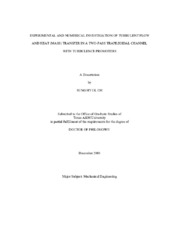| dc.description.abstract | Experiments and numerical predictions were conducted to study heat (mass) transfer characteristics in a two-pass trapezoidal channel simulating the cooling passage of a gas turbine blade. Three different rib configurations were tested for the air entering the smaller cross section of the trapezoidal channel as well as the larger cross section of the trapezoidal channel at four different Reynolds numbers of 9,400, 16,800, 31,800, and 57,200. (+) 60º ribs, (–) 60º ribs and 60º V-shaped ribs were attached on both the top and bottom walls in parallel sequence. A naphthalene sublimation technique was used, and the heat and mass transfer analogy was applied to convert the mass transfer coefficients to heat transfer coefficients. Numerical predictions of three-dimensional flow and heat transfer also were performed for the trapezoidal channel with and without 90º ribs tested by Lee et al. (2007). Reynolds stress turbulence model (RSM) in the FLUENT CFD code was used to calculate the heat transfer coefficients and flow fields at Re = 31,800. The results showed that the combined effects of the rib angle, rib orientation, and the sharp 180° turn significantly affected the heat (mass) transfer distributions. The secondary flows induced by the sharp 180° turn and the angled or V-shaped ribs played a very prominent role in heat (mass) transfer enhancements. The heat (mass) transfer enhancements and the pressure drops across the turn for 60° V-shaped ribs had the highest values, then came the case of (+) 60° ribs, and the heat (mass) transfer enhancements and the friction factor ratios for (–) 60º ribs was the lowest. However, comparing (–) 60º ribs with the 90º ribs, (–) 60º ribs produced higher heat (mass) transfer enhancements than the 90º ribs, as results of the secondary flow induced by the (–) 60º ribs. The overall average heat (mass) transfer for the larger inlet cases was always higher than that for the smaller inlet cases in the ribbed trapezoidal channel. Considering the thermal performance comparisons of the (+) 60° ribs, the (–) 60º ribs, and 60° V-shaped ribs for the smaller inlet cases, the highest thermal performance was produced by the (–) 60º ribs, and the 60° V-shaped ribs and the (+) 60° ribs had almost the same levels of the thermal performance since the 60° V-shaped ribs produced the highest heat (mass) transfer enhancement but also produced highest pressure drops. For the larger inlet cases, the (+) 60° ribs produced the highest values, then came the case of the 60° V-shaped ribs, and the thermal performance for the (–) 60º ribs was the lowest. The Reynolds stress model (RSM) showed well flow fields and heat transfer distributions but underpredicted average Nusselt number ratios. | en |


